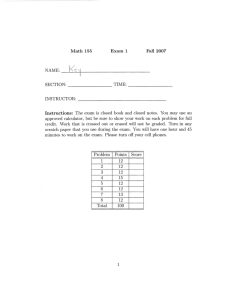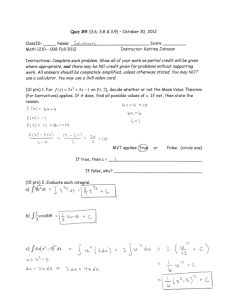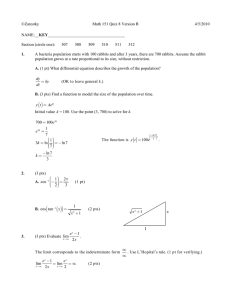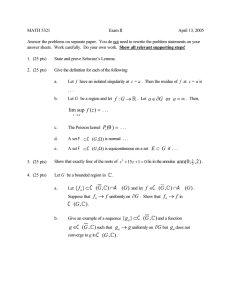Math 155 Exam 1 Fall 2007 NAME:
advertisement
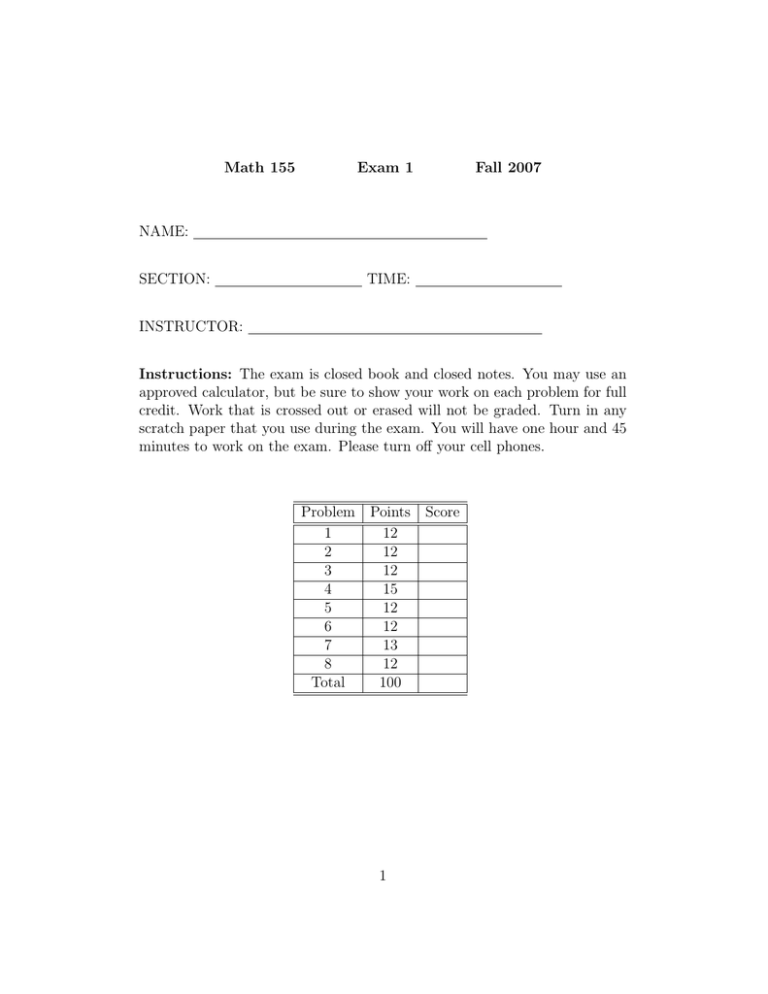
Math 155 Exam 1 Fall 2007 NAME: SECTION: TIME: INSTRUCTOR: Instructions: The exam is closed book and closed notes. You may use an approved calculator, but be sure to show your work on each problem for full credit. Work that is crossed out or erased will not be graded. Turn in any scratch paper that you use during the exam. You will have one hour and 45 minutes to work on the exam. Please turn off your cell phones. Problem Points 1 12 2 12 3 12 4 15 5 12 6 12 7 13 8 12 Total 100 1 Score 1. (12 pts) a) An ice cube tray contains 12 cubical spaces for ice, each of which is 1.25 inches per side. Ice has a density of 0.95 g/cm3 , and 2.54cm = 1 inch. What is the mass in grams of a fully filled tray? b) Write the equation of the line passing through the points (1, 3) and (3, 7) in slope-intercept form. c) Where is the function L(t) continuous? 2 if t 2t − 1 if L(t) = t + 3 if 2 Justify your answer. t≤1 1<t≤5 5<t 2. (12 pts) a) Graph the following discrete-time dynamical system and cobweb for three steps, starting from the initial condition. Label the coordinates of each point. bt+1 = 2.0bt − 2.0 starting from b0 = 2.2 b) For what positive initial values of bt is the solution of the discrete-time dynamical system increasing? What is the long-term behavior of the system for these values? c) Solve for the equilibrium point algebraically. Show all of your work to receive full credit. 3 3. (12 pts) Let f (x) = 3x2 + 2x − 5 a) Find the equation of the secant line to f that passes through (4, f (4)) and (4 + ∆x, f (4 + ∆x)). b) Find the slope of the secant line when 1. ∆x = 1 2. ∆x = 0.1 3. ∆x = 0.01 c) Find f 0 (4). d) What is the relationship between the answers to (b) and (c) ? 4 2 4. (15 pts) Suppose f (t) = 160e−t represents the amount of a radioactive substance present in a lake in parts per million (ppm), and the lake is considered safe to swim in when the amount of the substance in the lake is less than 10−3 ppm. Here t ≥ 0 represents time in weeks. a) Find the half-life of this radioactive substance. b) After how many weeks will the lake be safe to swim in? c) Plot the function f (t) on a semilog plot and label your axes. 5 5. (12 pts) The lung model, with absorption not proportional to the chemical concentration in the lung, is given by ct+1 = (1 − q)(ct − s) + qγ where γ is the chemical concenteration of ambient air, q is the fraction of air exchanged and s is the fraction by which the chemical concentration is reduced at each breath. a) Consider a lung with volume 2.0L that replaces 0.75L at each breath with ambient air, which has oxygen concenteration of 21%. What is the discrete time dynamical system for this model if the oxygen concenteration of the lung is reduced by 3% at each breath? b) What is the equilibrium concentration for the system in part (a)? c) Are there values of ct , where the system does not make sense? If so, what are they? 6 6. (12pts) Let Vt+1 represent the voltage of the AV node in the Heart Model. −ατ e Vt + u if e−ατ Vt ≤ Vc Vt+1 = e−ατ Vt if e−ατ Vt > Vc 1. Let e−ατ = .6, u = 10 and Vc = 20. a) If V0 = 27, will the heart beat? Why or why not? Calculate V1 . b) If V0 = 36, will the heart beat? Why or why not? Calculate V1 . 2. Let e−ατ = .25, u = 8 and Vc = 14. a) If this system has an equilibrium, find it. b) Graph this updating function below and cobweb to determine if the heart is healthy or sick. Label your axes. 7 7. (13pts) Suppose the function b(t) = t + t2 represents the size of a bacterial population in millions at time t hours. a) Find the average rate of change of the function b(t) as a function of ∆t. b) Show that the instantaneous rate of change of b(t) at time t = 0 is 1 million bacteria per hour. c) How small must ∆t be to get the average rate of change between t = 0 and ∆t to be within 1% of the instantaneous rate of change? 8 8. (12 pts) Evaluate the following limits, if they exist. Show all of your work and justify your answers. x2 + 5x + 2 x→3 x−1 a) lim b) lim+ f (x) where f (x) = x→0 3x2 + 2, −x, √ c) lim (3 x + cos x) x→π d) lim− x→0 1 x 9 if x > 0 if x ≤ 0
